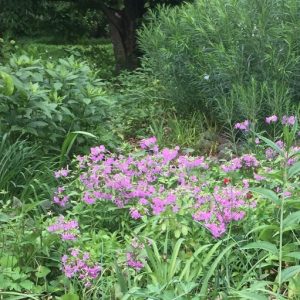I have reported on my experience with several low-growing native ground covers that seemed to be relatively immune to deer. I thought I’d revisit this topic, since it’s both perennial and evergreen (sorry, couldn’t resist).
In fact, many of our shade-loving native ground covers are semi-evergreen: the leaves mostly hang on over winter, growing more or less battered depending on the species and the local conditions. In the wild, our Piedmont forests would have a cover of fallen leaves at this time of year. The leaf litter acts as a weed barrier, temperature regulator, and moisture retainer, making way for the unfurling both of the spring ephemerals and of the new leaves of familiar woodland ground covers, such as wild ginger (Asarum canadense).
In a wooded Garden of Eden (with no invasive species), leaf litter might be all the mulch needed. But for most of us, of course, this just isn’t the case. Besides invasives, we have deer pressure, mixed sun and shade, compacted soils from construction or foot traffic, alternating downpours and droughts, and a lot of other challenges that point us to seek ground covers as green mulch, to be both a weed barrier and a carpet under other plants. So how nicely do these low-growing ground covers play with other plants?
The champion weed barrier/carpet maker is probably golden ragwort, Packera aurea, which not only grows thickly, but also remains fairly prominent in winter, which is great if you are under threat from lesser celandine. This plant has become very well known among native plant enthusiasts—even if some are not so enthusiastic about its spready tendencies. It does self-seed prolifically, which is great if you need to cover a lot of ground (if you don’t, you will have to supply the discipline to control it). It blooms less prolifically in shadier areas, but it is easy to speed up its spread by transplanting. I was delighted by how quickly it filled in under the shade of a yew hedge, when I replaced vinca with some of the excess ragwort from my garden paths.
As an underlying carpet, golden ragwort gets along fine with shrubs, larger bulbs, ferns, and large perennials, such as amsonia, boneset, goldenrod, Russian sage, and Joe Pye weed, to name a few. Smaller, shallow-rooted plants would probably be outcompeted, so keep your delicate little woodland flowers somewhere else. Golden ragwort is also pretty bullet-proof: when we had a nasty drought, I thought for a while that in the sunny spots, the dry heat had defeated it. However, it sprang back when the rain returned.
Another semi-evergreen is Allegheny spurge, Pachysandra procumbens. A handsome plant with interesting flowers, it is a slow spreader (certainly compared to the traditional nonnative Pachysandra terminalis), and it does not seem to be a robust competitor. Compared to a thick spreader like ragwort, it requires much more weeding as it establishes itself. In my experience, this pachysandra does not much like competition from other perennials, although it is fine with small bulbs and large woody plants. (Choose small bulbs, so that their leaves don’t spoil the look of the pachysandra flowers and new growth in spring.)
Phlox is often recommended as a ground cover for sun and part shade, but in my garden several species have been browsed into oblivion by deer and rabbits. However, about 6 years ago, I planted Phlox glaberrima as a specimen in a partly sunny area, and to my surprise, it has spread since then to the point of being a decent ground cover. It is said to be less attractive to deer than other types of phlox (and maybe foxes ate all the rabbits?). It is now surrounding other perennials, which continue to come up through it. Some weeds appear too, such as tree seedlings, but it seems to keep most at bay.

Sedges are a versatile group, with species adapted to many conditions, and they are generally deer-resistant. Popular choices for ground cover include Pennsylvania sedge (Carex pensylvanica), creeping sedge (Carex laxiculmus), meadow sedge (Carex flaccosperma), tussock sedge (Carex stricta), and common wood sedge (Carex blanda). I have had good success with Appalachian or mountain sedge (Carex appalachica), which has very fine leaves and is relatively short (about 6 inches high, with a weeping habit). It does well in dry conditions, so I put it under a Japanese maple, where it spread nicely. When it began to spread into a nearby area with more sun and moisture, it did not suppress really aggressive plants (like golden ragwort, for instance), but grew through them.
A sedge with more robust leaves, seersucker sedge (Carex plantaginea), gets a bit larger, and its puckered inch-wide leaves seem to do well in shading out competition. This is another woodland sedge, preferring light shade. The one specimen I put in has now multiplied and promises to be a good ground cover.
In my earlier article, I discussed lyreleaf sage (Salvia lyrata), plantain-leafed pussytoes (Antennaria plantaginifolia), and the notably thuggish woodland anemone (Anemone canadensis). I still have these in various places, but all three are now competing in one bed, along with some other aggressive plants, including bee balm (Monarda didyma), clustered mountain mint (Pycnanthemum muticum), and the redoubtable obedient plant (Physostegia virginiana). I’m not sure if anyone’s winning, but they’re still gamely duking it out.
—Barbara Collier